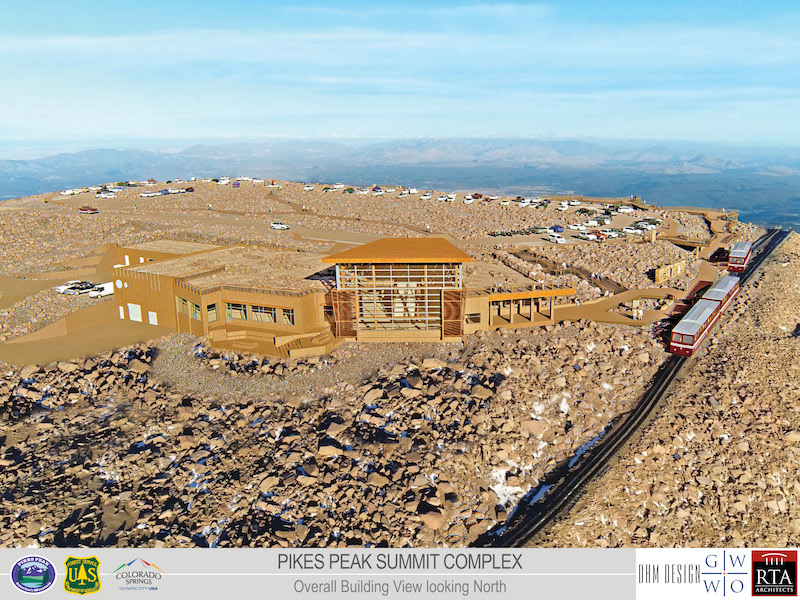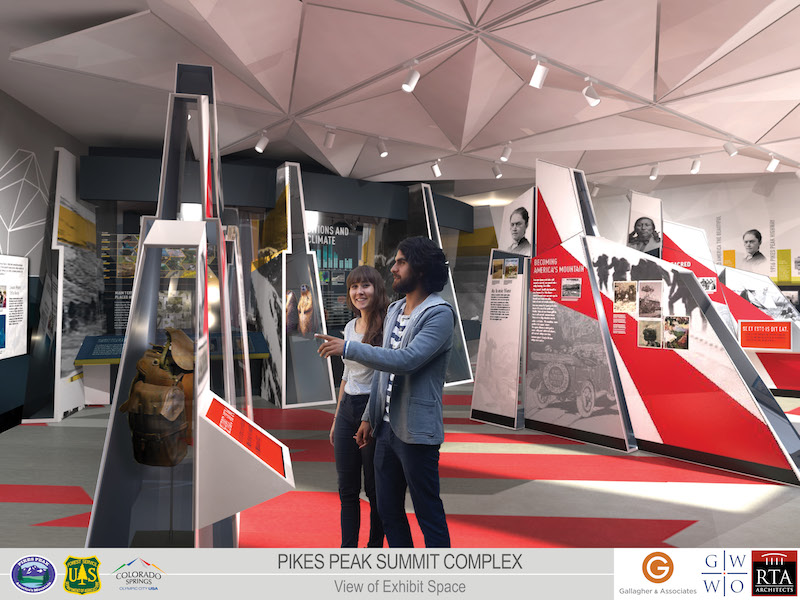More than 600,000 people annually scale the 14,115 feet to reach the summit of Pikes Peak in Colorado Springs, Colo. Until recently, they were greeted by a Summit Complex that had fallen into disrepair. But that’s about to change, as the city of Colorado Springs, in partnership with the U.S. Forest Service, U.S. Army Research Institute of Environmental Medicine, and Colorado Springs Utilities, is building a new Summit Complex and Visitors Center, which breaks ground on June 4.
A second site will consolidate a Plant Building, CSU Communications Facility, and High-Altitude Research Laboratory. The existing Summit House will remain open through the end of construction in the fall of 2020.
The project’s budget is $50 million. The building will be 26,000 sf (compared to the existing center’s 12,000 sf), and include a 200-seat dining area, gift shop, and parking for up to 200 cars.
Pikes Peak, which brigadier general and explorer Zebulon Pike discovered in 1806, is often called America’s Mountain, and its summit is a National Historic Landmark. Its scenic highway let’s anyone, regardless of age or physical condition, reach its apex, with recreation areas and trails along the way.
The intent of this project’s Building Team is to give a seamless, immersive, fully accessible experience with facilities specifically designed for the summit’s harsh environment. “Our goal was to put the experience of Pikes Peak first—the breathtaking views and spectacular beauty—while minimizing the visual impact of architecture on the mountain,” says Alan Reed, FAIA, Design Principal for GWWO Inc./Architects, the Baltimore-based firm that’s the project’s design architect.
RTA Architects is the architect of record. The rest of the Building Team includes HCDA Engineering (SE), Kiowa Engineering (CE) ME Group (MEP), GE Johnson Construction (GC), DHM Design (landscape architect), AECOM (extreme climate consultant), Gallagher & Associates (exhibit design), Jensen Hughes (code and accessibility consultant), The Preservation Studio (historic preservation), NASH Architectural Solutions (specifications), and Webb Foodservice Design (food service design).

The Summit Complex is being built on the southeast side of the mountain, which will help mitigate the effects of extreme winds and temperatures on the building. Image: RTA Architects, GWWO Inc./Architects
The Building Team sought public input for its final design, whose process began in 2015. The Complex’s exhibits will provide information about the Peak’s formation, discovery, and historical place. Visitors will also be able to experience the mountain via accessible trails and walkways.
The new Visitors Center will be encased in special glass with triple-glazed electrochromic material that darkens to cut glare and solar gain, helping to prevent excessive heat and marred views.
"Because the views are the whole thing," Stuart Coppedge, FAIA, Principal in Charge at RTA Architects, told the Colorado Springs Gazette. "We're really trying to avoid mechanical stuff that can break, that takes a lot of maintenance. The glass darkens to cut the glare. As the sun moves across the sky, the glass would track it around."
The large windows will also feature a ceramic frit that provides UV patterns in the glass that birds can see but people can't.

The exhibits will provide information about the mountain's formation, discovery, and historical place. Image: Gallagher & Associates, GWWO Inc./Architects
The project is pursuing LEED Gold and Living Building Challenge certifications. The Summit Complex is expected to produce more energy than it consumes, thereby reducing its operating costs and minimizing its ecological impact. Resilient materials, and its location on the southeast side of the mountain, will help the Complex resist extreme winds, temperatures, and freeze thaw cycles. And the site has been designed to take advantage of the mountain’s hydrological water flows.
”Our entire team embraced the technical challenges of this project with passion, skill and dedication, knowing how important and special Pikes Peak is,” says Coppedge.
Due to construction, parking at the site will be limited and restricted. And the Pikes Peak Cog Railway is closed indefinitely. So last Thursday, the city launched a more frequent shuttle service to the top. Between 30 and 35 shuttles seating 15 to 24 passengers each will make pickups and dropoffs every hour, with the goal of reducing waiting to no more than five minutes. The shuttles will run from May 31 through September 15, which are Pikes Peak’s highest volume months.
Related Stories
| Apr 12, 2011
Long-awaited San Francisco center is music to jazz organization’s ears
After 28 years, SFJAZZ is getting its first permanent home. The San Francisco-based nonprofit, which is dedicated to advancing the art of jazz through concerts and educational programs, contracted local design firm Mark Cavagnero Associates and general contractor Hathaway Dinwiddie to create a modern performance center in the city’s Hayes Valley neighborhood
| Apr 12, 2011
Entrance pavilion adds subtle style to Natural History Museum of Los Angeles
A $13 million gift from the Otis Booth Foundation is funding a new entrance pavilion at the Natural History Museum of Los Angeles County. CO Architects, Los Angeles, is designing the frameless structure with an energy-efficient curtain wall, vertical suspension rods, and horizontal knife plates to make it as transparent as possible.
| Apr 5, 2011
Zaha Hadid’s civic center design divides California city
Architect Zaha Hadid is in high demand these days, designing projects in Hong Kong, Milan, and Seoul, not to mention the London Aquatics Center, the swimming arena for the 2012 Olympics. But one of the firm’s smaller clients, the city of Elk Grove, Calif., recently conjured far different kinds of aquatic life when members of the City Council and the public chose words like “squid,” “octopus,” and “starfish” to describe the latest renderings for a proposed civic center.
| Mar 11, 2011
Chicago office building will serve tenants and historic church
The Alter Group is partnering with White Oak Realty Partners to develop a 490,000-sf high-performance office building in Chicago’s West Loop. The tower will be located on land owned by Old St. Patrick’s Church (a neighborhood landmark that survived the Chicago Fire of 1871) that’s currently being used as a parking lot.
| Feb 11, 2011
Sustainable features on the bill for dual-building performing arts center at Soka University of America
The $73 million Soka University of America’s new performing arts center and academic complex recently opened on the school’s Aliso Viejo, Calif., campus. McCarthy Building Companies and Zimmer Gunsul Frasca Architects collaborated on the two-building project. One is a three-story, 47,836-sf facility with a grand reception lobby, a 1,200-seat auditorium, and supports spaces. The other is a four-story, 48,974-sf facility with 11 classrooms, 29 faculty offices, a 150-seat black box theater, rehearsal/dance studio, and support spaces. The project, which has a green roof, solar panels, operable windows, and sun-shading devices, is going for LEED Silver.
| Feb 11, 2011
BIM-enabled Texas church complex can broadcast services in high-def
After two years of design and construction, members of the Gateway Church in Southland, Texas, were able to attend services in their new 4,000-seat facility in late 2010. Located on a 180-acre site, the 205,000-sf complex has six auditoriums, including a massive 200,000-sf Worship Center, complete with catwalks, top-end audio and video system, and high-definition broadcast capabilities. BIM played a significant role in the building’s design and construction. Balfour Beatty Construction and Beck Architecture formed the nucleus of the Building Team.
| Feb 11, 2011
Kentucky’s first green adaptive reuse project earns Platinum
(FER) studio, Inglewood, Calif., converted a 115-year-old former dry goods store in Louisville, Ky., into a 10,175-sf mixed-use commercial building earned LEED Platinum and holds the distinction of being the state’s first adaptive reuse project to earn any LEED rating. The facility, located in the East Market District, houses a gallery, event space, offices, conference space, and a restaurant. Sustainable elements that helped the building reach its top LEED rating include xeriscaping, a green roof, rainwater collection and reuse, 12 geothermal wells, 81 solar panels, a 1,100-gallon ice storage system (off-grid energy efficiency is 68%) and the reuse and recycling of construction materials. Local firm Peters Construction served as GC.
| Feb 11, 2011
Former Richardson Romanesque hotel now houses books, not beds
The Piqua (Ohio) Public Library was once a late 19th-century hotel that sat vacant and deteriorating for years before a $12.3 million adaptive reuse project revitalized the 1891 building. The design team of PSA-Dewberry, MKC Associates, and historic preservation specialist Jeff Wray Associates collaborated on the restoration of the 80,000-sf Richardson Romanesque building, once known as the Fort Piqua Hotel. The team restored a mezzanine above the lobby and repaired historic windows, skylight, massive fireplace, and other historic details. The basement, with its low ceiling and stacked stone walls, was turned into a castle-like children’s center. The Piqua Historical Museum is also located within the building.
| Feb 11, 2011
Sustainable community center to serve Angelinos in need
Harbor Interfaith Services, a nonprofit serving the homeless and working poor in the Harbor Area and South Bay communities of Los Angeles, engaged Withee Malcolm Architects to design a new 15,000-sf family resource center. The architects, who are working pro bono for the initial phase, created a family-centered design that consolidates all programs into a single building. The new three-story space will house a resource center, food pantry, nursery and pre-school, and administrative offices, plus indoor and outdoor play spaces and underground parking. The building’s scale and setbacks will help it blend with its residential neighbors, while its low-flow fixtures, low-VOC and recycled materials, and energy-efficient mechanical equipment and appliances will help it earn LEED certification.
| Feb 11, 2011
Texas megachurch inspired by yesteryear’s materials, today’s design vocabulary
The third phase of The First Baptist Church of Pasadena, Texas, involves construction of a new 115,000-sf worship center addition. Currently in design by Zeigler Cooper, the project will include a 2,500-seat worship center (with circular layout and space for a 50-person orchestra and 200-person choir), a 500-seat chapel (for weddings, funerals, and special events), and a prayer room. The addition will connect to the existing church and create a Christian Commons for education, administration, music, and fellowship. The church asked for a modern design that uses traditional materials, such as stone, brick, and stained glass. Construction is scheduled to begin this summer.

















